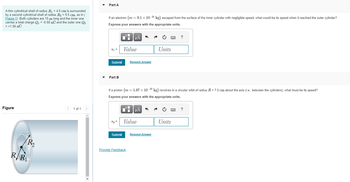Question

Transcribed Image Text:A thin cylindrical shell of radius R₁ = 4.5 cm is surrounded
by a second cylindrical shell of radius R₂ = 9.5 cm, as in (
Figure 1). Both cylinders are 15 m long and the inner one
carries a total charge Q₁ = -0.68 nC and the outer one Q2
= +1.56 nC.
Figure
RR
R₂
1 of 1
Part A
If an electron (m = 9.1 x 10-31 kg) escaped from the surface of the inner cylinder with negligible speed, what would be its speed when it reached the outer cylinder?
Express your answers with the appropriate units.
Ve=
Submit
Part B
Up =
Submit
Value
0
μÅ
If a proton (m = 1.67 x 10-27 kg) revolves in a circular orbit of radius R = 7.0 cm about the axis (i.e., between the cylinders), what must be its speed?
Express your answers with the appropriate units.
Request Answer
Provide Feedback
ī
μA
Value
Units
Request Answer
wwww
?
Units
?
Expert Solution
This question has been solved!
Explore an expertly crafted, step-by-step solution for a thorough understanding of key concepts.
Step 1: Outline the steps to solve the problem
VIEW Step 2: Find electric field in the region between shells
VIEW Step 3: Find potential difference between the two shells
VIEW Step 4: Find velocity of electron when it reaches outer shell
VIEW Step 5: Find velocity of proton in circular motion around inner shell
VIEW Solution
VIEW Step by stepSolved in 6 steps with 33 images
